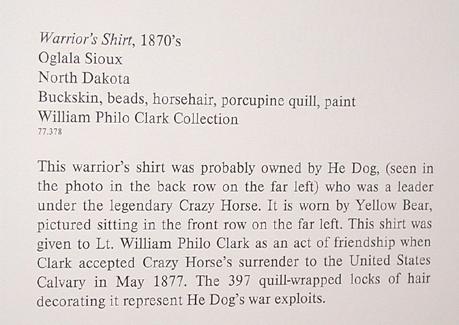In
1877, standing at the left of this delegation photo (you
can see the shirt worn by the man sitting at the farthest
left):
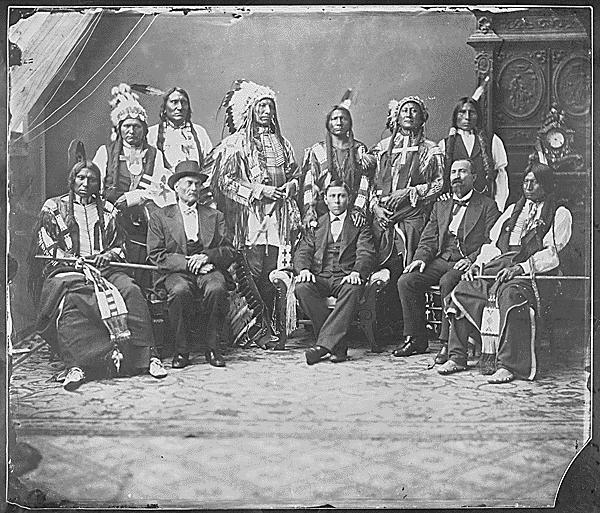
Photo by Mathew Brady. There are several other known delegation
photographs from this trip in which He Dog appears.
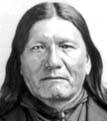
He
Dog in the late 1880s-91 (probably from the 1891 delegation
to Washington):
At
Plenty Horses' Trial (he's the one sitting at the left):
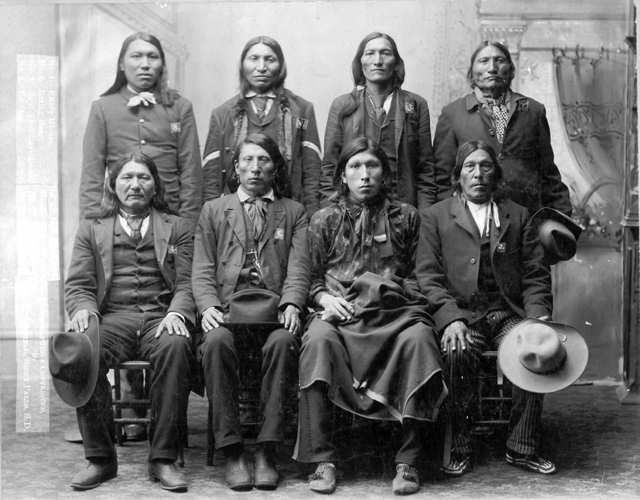
All photos above contributed by Grahame Wood.


One
of two 1928 images of He Dog. As I recall, they were part
of a survey conducted by the Office of Indian Affairs
to determine the economic status of the Lakota on the
reservations. It is on the Oglala Lakota College website
and was published in Donovin Sprague's book of photographs
from Pine Ridge Reservation, published by Arcadia Press.
— Ephriam Dickson

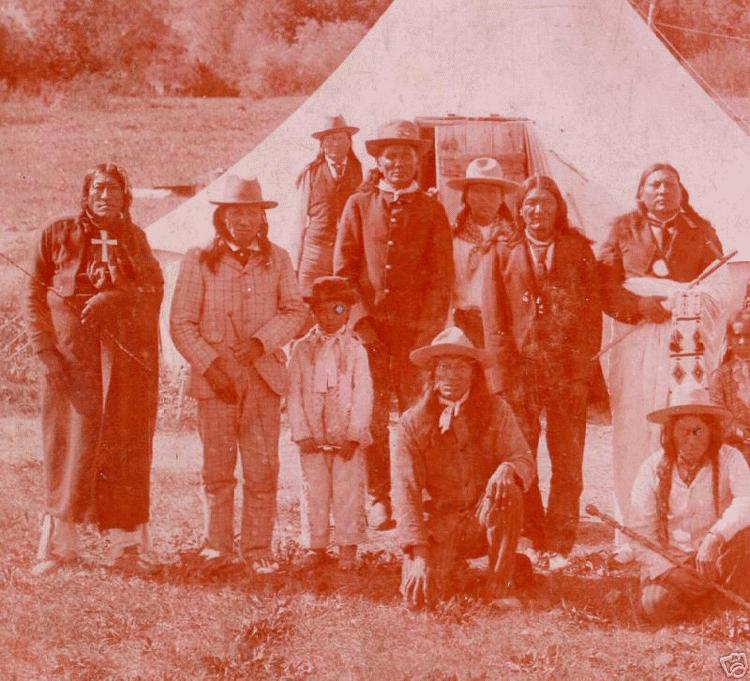
By G.G. McBride, Fort Robinson, Nebraska
(standing 2nd from right - He Dog) —
Dietmar Schulte-Möhring

Above
is a photograph by McBride, from Crawford, Nebraska, taken
at the old Red Cloud Agency site. I do not have much on
McBride, except that he first appears in the Nebraska
Gazeteer as a photographer in Crawford, Nebraska, in 1894.
He was gone by the time the next edition came out in 1902.
—
Ephriam Dickson

The
man to the right looks like the Spotted Elk on the 1891
Oglala delegation photo. —
Grahame Wood

I
would guess that it was made around 1890, judging from
the faces of He Dog and Spotted Elk, who don´t look
much older or younger than in 1891. —
Dietmar Schulte-Möhring

Here
is the complete picture:

I
believe the man on the far left with the cross is the
Oglala, Iron Hawk. I made a comparison with a photo from
the "iPhoto Central" web site.

Also
a comparison with a SIRIS photo of the Oglala Spotted
Elk:
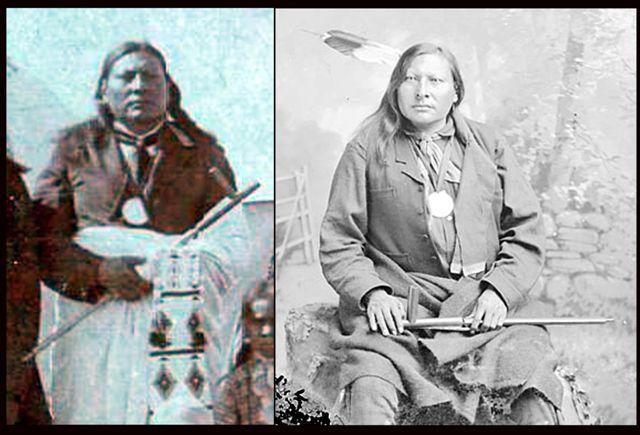
Comparisons made by Bob / buffaloman.

Just
an observation on the photograph taken near the site of
Red Cloud Agency No. 2. He Dog's younger brother Grant
Short Bull and their nephew (they would have called him
their 'son') Amos Bad Heart Bull were both enlisted as
scouts and based at Ft Robinson in the early 1890s: could
they be included in this photo? With both He Dog and Iron
Hawk present, the correlation with the memebership of
the Sore-Backs sub-band seems very strong.
According
to John Colhoff, in one of his letters to Joseph Balmer,
the two Short Bulls - He Dog's brother and the Brule Ghost
Dance leader - were cousins. —
Kingsley Bray

I
am not aware of any identified photographs of Short Bull
(He Dog's brother). I have been recently in contact with
the great-grandson of Short Bull and they do not have
any photographs either. Unfortunately, Short Bull and
much of his family were killed in a tragic car accident
in 1935 so much of the family oral history was lost.
Kingsley
may be right that Short Bull and his nephew Amos Bad Heart
Bull could be in the photograph, though I am not certain
how we can demonstrate that without another identified
photograph. Amos did serve a sixth month stint as an Indian
scout at Fort Robinson beginning in March 1894 (under
the name Eagle Lance), joining his uncle Short Bull who
was by then serving his seventh enlistment including several
years at Fort Robinson. The timing would be right for
them to be in the photograph.
Finally,
someone asked about the meaning of the silver crosses
visible in a number of Cheyenne and Lakota portraits.
I recently wrote an article, "German Silver Crosses
in Lakota Attire: Personal Adornment or Symbols of Tribal
Leadership?" in the March/April 2005 issues of Whispering
Winds that looked at these interesting items. I listed
every known image or surviving example of these crosses
(I have since located additional ones) and tried to argue
that they may represent some office or leadership role
among the Lakota. Here is the concluding paragraph:
"In
summary, the available evidence suggests that the Great
Plains metal crosses originated within the southwestern
silverwork industry and then spread successively northward,
first to the Apache, Comanche and Kiowa, and then to the
Southern Cheyenne and Northern Cheyenne by the 1860's
and the Lakota by the 1870's. These ornaments declined
in popularity during the two decades that followed. The
Big Road Roster suggests that rather than just ornamentation,
the German silver crosses worn by the Lakota during the
1870's may have had some cultural significance, the meaning
of which has unfortunately become lost. The evidence is
admittedly far from conclusive, but perhaps one day, additional
sources will be found that may shed light on the meaning
of these intriguing elements of Lakota material culture."
— Ephriam Dickson

The
McBride photo was first (I guess) published in 1976, without
any identification, by the Nebraska State Historical Society,
illustrating their fascinating "Oglala Sources On
The Life Of Crazy Horse", the Eleanor Hinman interviews.
But it became soon clear that this was a portrait of He
Dog and his family and followers. I am convinced that
the small man in the suit (second from left) is indeed
He Dog's brother, Grant Short Bull. I have two other portraits
of him for comparison (both Nebraska State Historical
Society). The first, taken ca.1920, depicts him standing
in full Indian attire together with an old friend of the
Red Cloud family, Captain James H. Cook. The second image
is a 1933 group photo of the Red Cloud family and friends.
Short Bull is identified as the small man holding a large
beaded tobacco bag, standing quite in the middle between
James Red Cloud and Lone Man (eighth person from the left).
What about the young man standing right behind He Dog,
sporting a cowboy hat and a large bandana? I always loved
to think that this was He Dog's artist nephew/son, Amos
Bad Heart Bull. Of course I can't offer any proof. But
didn't he portray himself much like this in his drawings?
— Hans Karkheck

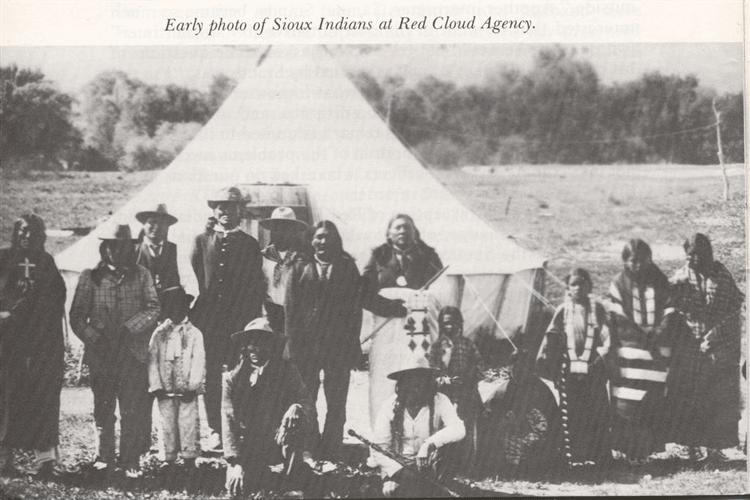


Here
is the name list of the above photo, as published by the
Nebraska State Historical Society (left to right): Pine
Ridge Supt. McGregor, John Kills Above, Susie Kills Above,
Silas Fills The Pipe, Delia Red Cloud, Agnes Red Cloud,
James Red Cloud, Short Bull, Lone Man, Fast Whirlwind,
Stanley Red Feather, Samuel Rock, Amos Afraid Of His Horses,
Emil Afraid Of Hawk, Oliver Jumping Eagle, Herbert Bissonette,
Robert Fast Horse, Captain Luther H. North.
The
Short Bull & James H. Cook photo was published in
NEBRASKA HISTORY, Vol.22, No.1, 1941. It had actually
been taken in September 1934, a year before Short Bull
was killed in a car accident near Oglala, South Dakota.
This
is what Cook had to say about the picture: "The photograph
was taken at Fort Robinson by an artist unknown to me,
at the time (September 4-5, 1934) when cenotaphs were
dedicated to Lieutenant Levi Robinson (in whose honor
the fort was named) and to Crazy Horse, brave Indian and
leading Sioux warrior. Short Bull who stands beside me
was a brother of He Dog. Both participated in the fight
with General Custer when his command was wiped out"
(NH 22:1, 1941, 74).
— Hans Karkheck

If
the individual in the McBride photograph (second from
left) is actually Grant Short Bull, then I suspect the
boy standing next to him is his son Charles Short Bull,
who would have been about 8 or 10 years old when the image
was made. Grant also had a daughter, but she was not born
until 1895. Perhaps one of the women standing to the right
is his wife, Good Hawk.
The
photograph of Captain Cook and Short Bull was indeed taken
in 1934 at the dedication of the two stone pyramids at
Fort Robinson, one dedicated to Crazy Horse and the other
to Lieut. Robinson killed in 1874. They are both standing
in front of the Post Headquarters, today the Fort Robinson
Museum. — Ephriam Dickson

Photographs
from the Morris County (New Jersey) Museum:
